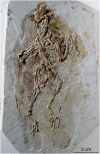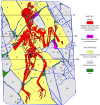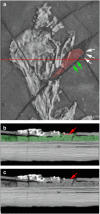X-ray computed tomography datasets for forensic analysis of vertebrate fossils
- PMID: 27272251
- PMCID: PMC4896130
- DOI: 10.1038/sdata.2016.40
X-ray computed tomography datasets for forensic analysis of vertebrate fossils
Abstract
We describe X-ray computed tomography (CT) datasets from three specimens recovered from Early Cretaceous lakebeds of China that illustrate the forensic interpretation of CT imagery for paleontology. Fossil vertebrates from thinly bedded sediments often shatter upon discovery and are commonly repaired as amalgamated mosaics grouted to a solid backing slab of rock or plaster. Such methods are prone to inadvertent error and willful forgery, and once required potentially destructive methods to identify mistakes in reconstruction. CT is an efficient, nondestructive alternative that can disclose many clues about how a specimen was handled and repaired. These annotated datasets illustrate the power of CT in documenting specimen integrity and are intended as a reference in applying CT more broadly to evaluating the authenticity of comparable fossils.
Conflict of interest statement
The authors declare no competing financial interests.
Figures














Comment on
-
Crystal structure of rhodopsin bound to arrestin by femtosecond X-ray laser.Nature. 2015 Jul 30;523(7562):561-7. doi: 10.1038/nature14656. Epub 2015 Jul 22. Nature. 2015. PMID: 26200343 Free PMC article.
-
The trickle before the torrent-diffraction data from X-ray lasers.Sci Data. 2016 Aug 1;3:160059. doi: 10.1038/sdata.2016.59. Sci Data. 2016. PMID: 27479637 Free PMC article.
References
Data Citations
-
- Rowe T., Luo Z., Ketcham R. A., Maisano J. A., Colbert M. W. 2016. Figshare. http://dx.doi.org/10.6084/m9.figshare.c.1612235 - DOI
References
-
- Charlesworth E. Hawkins’ sale to the British Museum and his criminal libel case against Charlesworth. Ann. Mag. Nat. Hist. new series 4, 11–44 (1840).
-
- Wellnhofer P. Campylognathoides liasicus (Quenstedt), an upper Liassic pterosaur from Holzmaden—the Pittsburgh specimen. Ann. Carnegie Mus. 45, 5–34 (1974).
-
- McGowen C. Problematic ichthyosaurs from southwest England: a question of authenticity. J. Vert. Paleontol. 10, 72–79 (1990).
-
- Sereno P. & Wild R. Procompsognathus: theropod, ‘thecodont’ or both? J. Vert. Paleontol. 12, 435–458 (1992).
-
- Stokstad E. Learning to dissect dinosaurs—digitally. Science 288, 1728–1732 (2000). - PubMed
Publication types
MeSH terms
Grants and funding
- GM094599/GM/NIGMS NIH HHS/United States
- GM097463/GM/NIGMS NIH HHS/United States
- U54 GM094618/GM/NIGMS NIH HHS/United States
- DK071662/DK/NIDDK NIH HHS/United States
- ACB-12002/PHS HHS/United States
- AGM-12006/PHS HHS/United States
- P50 GM073197/GM/NIGMS NIH HHS/United States
- P50 GM073210/GM/NIGMS NIH HHS/United States
- U54 GM094586/GM/NIGMS NIH HHS/United States
- GM104212/GM/NIGMS NIH HHS/United States
- R01 GM095583/GM/NIGMS NIH HHS/United States
- R01 GM108635/GM/NIGMS NIH HHS/United States
- GM102545/GM/NIGMS NIH HHS/United States
LinkOut - more resources
Full Text Sources
Other Literature Sources
Medical

